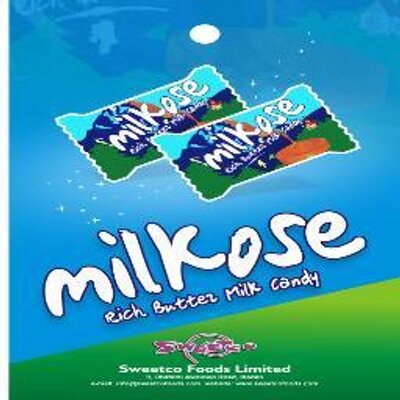
MILKOSE (RICH BUTTER
MILK CANDY)
INGREDIENTS USED IN
MILKOSE: Glucose syrup, sugar, full cream condensed milk, vegetable fat, salt,
lecithin and vanillin.
What is candy?
According
to Wikipedia, Candy, also called
sweets or lollies, is a confection
that features sugar
as a principal ingredient. Vegetables, fruit, or nuts which have been glazed
and coated with sugar are said to be candied.
Physically,
candy is characterized by the use of a significant amount of sugar or sugar
substitutes.
Are there positive and
negative effects of eating candy or sweet?
HEALTH
EFFECTS OF EATING CANDY OR SWEET
Cavities:
Candy generally contains sugar, which is a key environmental
factor in the formation of dental caries (cavities). Several types of bacteria
commonly found in the mouth consume sugar, particularly Streptococcus mutans. When these
bacteria metabolize the sugar found in most candies, juice, or other sugary
foods, they produce acids
in the mouth that demineralize the tooth enamel
and can lead to dental caries. Heavy or frequent consumption of high-sugar
foods, especially lollipops, sugary cough drops, and other sugar-based candies
that stay in the mouth for a long time, increases the risk of tooth decay.
Glycemic index
Most candy, particularly low-fat and fat-free candy, has a
high glycemic index (GI), which means that it causes
a rapid rise in blood sugar levels after ingestion. This is
chiefly a concern for people with diabetes,
but could also be dangerous to the health of non-diabetics.
HEALTH BENEFITS OF EATING CANDY OR SWEET
Candies that primarily consist of peppermint and mint, such as candy canes,
have digestive benefits. Peppermint oil can help soothe an upset stomach by
creating defense against irritable bowel syndrome and is effective
in killing germs.
In a study of approximately 8,000 individuals, candy consumers enjoyed an
average of 0.92 years of longer life, with greater consumption of candy not
associated with progressively lower mortality. Mortality was lowest among those
consuming candy 1–3 times a month and highest among those consuming candy three
or more times a week.
LET’S LOOK AT THE
INGREDIENTS IN THIS PARTICULAR CANDY MILKOSE
Glucose syrup: glucose
syrup is simply an added sweetener
Sugar: Sugar is the generalized name for
sweet, short-chain, soluble carbohydrates,
many of which are used in food. They are composed of carbon, hydrogen, and
oxygen.
Full cream condensed
milk: Condensed milk is cow's milk
from which water
has been removed. It is most often found in the form of sweetened condensed
milk, with sugar
added, and the two terms "condensed milk" and "sweetened
condensed milk" are often used synonymously today.
Vegetable fat: A
fat is considered to be a vegetable fat if it comes from plant-based sources
instead of originating from an animal. Eating foods that contain healthy
vegetable fats as a replacement for saturated fats and trans fats in your diet
can help keep your heart healthy by improving your cholesterol.
Salt: Salt is
essential to the health of humans and is one of the five basic taste sensations.
Lecithin: Lecithin originated from the
Greek “Lekithos,” referring to egg yolk. Lecithin is a common compound found in
cells of all living organisms, its presence is required for proper biological
function. It also is an edible and digestible surfactant and emulsifier. It is
used as an emulsifying and stabilizing agent in the food (eg, margarine,
chocolate production)
Vanillin: Vanillin is a vanilla extract
alternative made from wood pulp. It is commonly used to reduce production
costs. And, unlike real vanilla extract which is produced from real vanilla
beans, vanillin is synthetic and may be produced using petrochemicals and
byproducts from the paper industry. Unfortunately, because it’s cheap, the
stuff is everywhere. Vanilla flavored over-the-counter medicines, beverages,
and cookies are all places you’re likely to find vanillin.
please note that the information in this product can be useful for any other type of sweet or candy that uses the same ingredients. this product is only used as an example
moderation is the key to a healthy living.
References:
https://en.wikipedia.org/wiki/Salt#Edible_salt
No comments:
Post a Comment